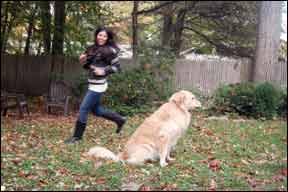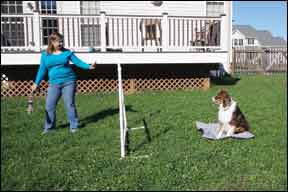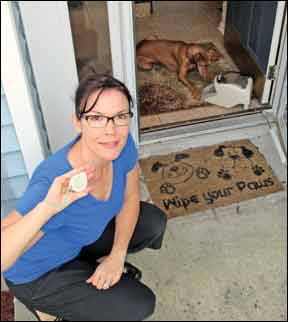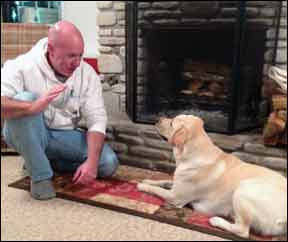It’s 6 a.m., and barely beginning to get light outside. I trudge to the barn with Bonnie at my side to join my husband Paul, who has already started barn chores with the rest of the dogs. On the way, I stop to pick up empty feed pans from the horses, who have finished their morning grain. I cue Bonnie to sit, and stay, so my energetic dark-colored dog doesn’t disappear into the blackness. I enter the pasture, pick up the pans, and just as I move back toward the gate, I see Bonnie’s ears prick and eyes light up in excited anticipation as she looks to my left.
“Stay!” I remind her, as I follow her gaze just in time to see Dorothy, the neighbor’s mostly-white calico cat fade into the brush. Thankfully, Bonnie stays, although she is quivering with excitement, and on the tips of her toes. I exit the pasture and return to Bonnie’s side, then give her an “Okay!” release cue, trusting that dog-savvy Dorothy has had ample time to find a safe perch in the woods. Bonnie dashes into the brush on her happy but fruitless cat-quest. She returns a few moments later when I call her back, grinning from ear-to-ear. We just “Premacked” Bonnie’s “stay.”

288
The cue “Stay,” in my world, means “Stay in the exact position I left you in until I release you,” as opposed to “Wait,” which simply means “Pause.” I tell my dogs to “Wait” when I go out the door, because they are free to move around as soon as the door closes. I use “Stay” when I really do need my dogs to be solidly, reliably parked in one spot for a length of time. I don’t use it nearly as much as I did when I was actively competing in obedience and rally, but it still comes in handy at times.
Old Way/New Way
When coercion training was the only game in town, we used to teach stays by telling the dog to sit and stay, marching to the end of the leash, and turning around to glare sternly at the dog, as if daring her to move. If she did, we scuttled back in, leash in hand, and delivered a resounding “correction” (i.e. punishment) for the transgression by yanking, hard, on the dog’s choke collar. It was not uncommon to see dogs cringing in fear as their owners rushed back to them, or jumping up and running off across the training ring in an attempt to avoid the impending punishment.
Of course, the enlightened positive reinforcement-based trainer of today wouldn’t dream of using this method. The last thing we want to do is cause our dogs to be fearful and run from us. Rather than punishing the dog for moving, we reinforce her for staying. It’s as simple as that.
There are lots of different ways to reinforce a stay behavior. In Bonnie’s case above, I used the “Premack Principle,” which says you can use a higher probability/value behavior to reinforce a lower probability/value behavior. I reinforced her for staying (the not-so-fun behavior) by giving her permission to chase the cat (the more-fun behavior).
Of course, Bonnie already knew what stay meant, because I had trained her to stay in a less distracting environment – the safe and quiet confines of the training center. Without corrections; we train the stay behavior with clicker and treats, starting with a stay of very short duration – a second or two, and gradually shaping for longer and longer stays. Here’s how:
Teaching the Stay
While your dog is in a “sit” or “down,” say “Stay” and hold up a treat for one second. If he stays in place, click your clicker or say “Yes!” and feed him the treat. At first, hold the treat right in front of his nose, if necessary, to keep him in place. If he gets up, say “Oops!” in a cheerful voice, whisk the treat behind your back, and ask him to sit again.

288
Repeat this step until he realizes that getting up makes the treat disappear. Very gradually extend the length of time you ask for the stay, just a second or two longer every half-dozen successful repetitions. As he gets the idea, start taking the treat away from his nose so he’s holding the stay without the lure.
Always use a release word to end the stay. This will help your dog understand that the stay isn’t over until you release him. I suggest you return to him and pause for varying amounts of time before you give the release so he understands that he doesn’t get up just because you returned, but that he actually has to wait for you to give him the cue. If you release him immediately every time you return, he’ll think your return is the release cue.
The word “Okay” is often used as a release cue (I use it!), but is sometimes not recommended because of its common use in conversation. Perhaps you have your dog on a down-stay at the beach and you turn to your spouse and say, “Okay, let’s go to the movies tonight.” Whoops – there goes your dog! Other frequently used release cues include “free,” “free dog,” “all done,” “at ease,” “release,” “wheee!” You can, of course, use any word or words you want; they have no meaning to your dog until you give them meaning by associating them with the release.
When releasing your dog from the stay, get excited, encourage him to get up, and praise him when he does. It’s important that he actually gets up when you give the release – so you know he understands the stay is over.
Many roads to Rome
Like all good positively trained behaviors, there are a variety of ways to go about teaching “stay.”
Jessica Miller, one of the PMCTs (Pat Miller Certified Trainers) at Peaceable Paws, likes to use a mat to help a dog stay in place. She says, “I like to start teaching stay as a mat behavior first. Once the dog has a good ‘go to mat’ and gets reinforced for being on the mat a lot (for duration), I then begin to add the ‘stay’ cue as a sort of ‘mat for duration.’ The good thing about this is that once you’ve reinforced being on the mat a lot most dogs don’t want to get up. I then begin working on generalizing it to other areas/surfaces. They get the picture pretty quickly.
“This worked wonderfully for my start-line stay in agility and for group long stays in obedience competition. I started with the mat in both venues (because they were specific situations in which I wanted a solid stay) and then after about two sessions I took the mat away and the stay remained. If the behavior starts to deteriorate, bring the mat back for a few attempts. You could ‘fade’ the mat (use a smaller and smaller piece until it’s gone), but I’ve never had to. Once the mat was gone the cue and behavior remained pretty solid.”
C.C. Casale, a PMCT with her own training business, South Paw Pet Care, in Mount Pleasant, South Carolina, goes high-tech to reinforce her dogs’ stays.

288
“I like to use the Manners Minder Remote Reward Training System to teach stay. In this instance it works much like a clicker, since it can be set to make a beep sound before dispensing, so the dog receives a positive alert that he is doing the right thing and a reward is on its way!
“This creates further incentive, which tends to speed up the process of moving toward and working on ‘stay for duration.’ I set the machine to manual so I (and my clients) can use the hand held remote control to dispense treats based on the schedule of reinforcement we have chosen for that session and moment.“We first work on prolonged stays with no distance between the dog and trainer. Then we increase the distance based on the rate of success and reward the dog for longer and longer stays. The machine allows us to dispense a single treat or several, so we ending training sessions on a high note by ‘jackpotting’ with several treats for meeting whichever criteria we have set for that session. It’s pretty fun to see dogs (especially high-energy ones) get excited about staying in place.
“This method has worked well for me. As an added benefit, the familiarity the dog and client get with the Manners Minder then translates to using the tool for other training behaviors like ‘go to your place.’ ”
Bob Ryder, PMCT, CPDT-KA, of Pawsative Transformations in Normal, Illinois, uses arcs, tethers, and exercise to increase his success with stays.

288
“I keep it pretty simple, starting with a super high rate of reinforcement for a sit or down stay (whichever comes more naturally for the dog), and moving in small arcs around the dog. I might use a tether briefly if necessary. I increase distance in half-step increments making the arcs into portions of concentric circles. Once the dog is solid at that level, I begin moving away in direct lines as I finish each arc, returning each time to reward from up close. First I’ll back away while facing the dog. Then I’ll work at a shorter distance again, now moving away from the dog and facing 90 degrees away. When that’s solid, I work at a short distance again and retreat from the dog facing 180 degrees away.
“For young and energetic dogs, we work after some exercise. It makes a big difference!”
Way to relax!
A number of trainers use the Karen Overall Protocol for Relaxation (PFR) as a tool to teach dogs to stay on cue. Although designed to help anxious dogs learn how to relax, the PFR is a perfect tool for teaching stays, as it breaks the behavior down into very small increments (see “Karen Overall’s Protocol for Relaxation,” next page). Sean Howard, PMCT, of Up With Pup, in Toronto, Canada, and Elizabeth Adamec, of Sweet Wag, in Boston, Massachusetts, both like to take advantage of the specificity of the PFR. Adamec says, “I have most of my clients work on Overall’s Protocol for Relaxation starting week one, twice a day. I tell them, now is your chance to talk at your dog non-stop. Say ‘Stay’ all you want, it doesn’t matter. Think of it as doggy yoga. It’s about being calm and understanding and not caring if they mess up. Use your Yogi voice. I tell them to try to sound like a new-age DVD on how to be peaceful. Then when we are ready to do stays a few weeks later the dogs are all primed up.
“It works like a dream. Takes the pressure off the client to be perfect at first, and that takes the pressure off the dog. I started doing it this way after I noticed that my private clients with crazy dogs did the best on their stays. It’s because all of the work they’ve been doing with the PFR twice a day.”
Howard adds, “I use Karen Overall’s PFR with great success to build to an extended series of stays in a variety of stimulating scenarios; my favorites are having a client walk to the door to have a conversation, open their dog’s food bin, and so on.”
So, for the sake of your neighbor’s cat, the squirrels in your yard, your dog’s safety and your own peace of mind, it’s worth investing the time and energy into teaching your dog a good, reliable stay behavior. For the sake of your relationship with your dog, choose one of the modern, positive, fun methods described here to teach it, so your dog will happily stay without the need for stern gazes and threats of punishment.
Thanks to Shagay Anselment of The Canine Connection, Chico, CA, for demonstrating some of the techniques in this article. See “Resources,” for contact information.





